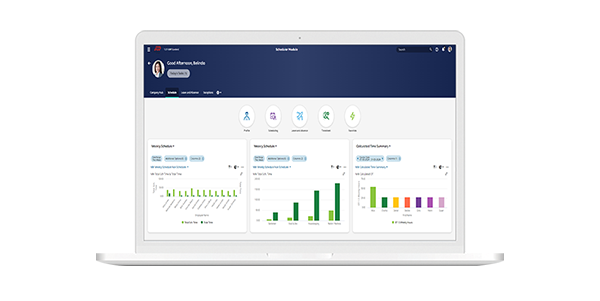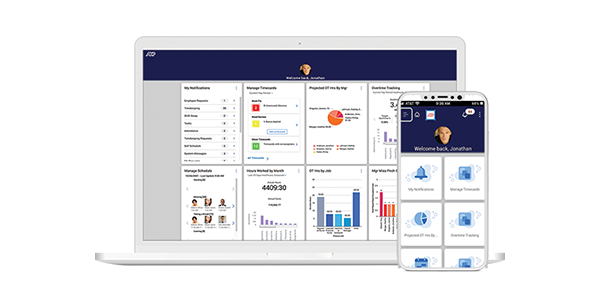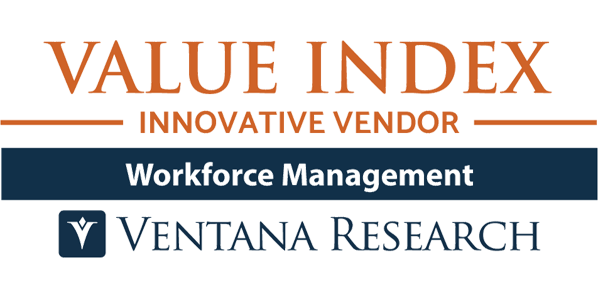Workforce management solutions
Boost employee productivity and increase performance with powerful workforce management solutions from ADP

Maximise the performance of your workforce solution
Whether you’re a company with complex time and attendance requirements, or you just need to streamline your staff scheduling, timesheets and reporting, at ADP we have the workforce management solutions to help you maximise the performance of your employees.
Our workforce management solutions support over 80,000 businesses like yours with anything from strategic scheduling and planning, to enabling efficient communication and real time collaboration. We’re also recognised as overall leader in Ventana Research’s 2022 Value Index for workforce management.
Benefits of ADP workforce management include:
More control
over staff costs
over staff costs
Reduced
compliance risks
compliance risks
Enhanced employee productivity
More engaged employees1
Everything you need in one solution
Our workforce management software delivers more than time and attendance. From payroll and compliance, to analytics, scheduling and absence management – all delivered with our exceptional customer service.
Improve efficiency with time and attendance tracking
Time tracking is now easy, convenient and accurate, and accessible via our mobile app. Now you can:
- Avoid paper timesheets with digital time clocking, saving staff up to 30 minutes per month 2
- Save an average of 40 minutes weekly with automated alerts, timecard approvals, scheduling, and exception reports 3
- Improve timecard accuracy and avoid "buddy punching" by using time clocks with optional finger or face-scan identification if local regulations allow

Reduce staff costs with accurate scheduling
A report by Aberdeen Group found that businesses who automate scheduling saw five percent greater workforce capacity and 24 percent higher engagement levels, due to scheduling transparency: 4
- Easily create schedules with a system that helps you visualise workforce needs, find the best person for a shift, share open shifts and manage shift swapping
- Gain visibility into actual versus scheduled hours, earned hours, overtime and other real-time analytics so you and your managers stay on budget

Manage accrued time, leave, and attendance policies
Our automated workforce management software lowers your staff costs, reducing up to 33 per cent of unplanned overtime: 5
- View accrued time-off balances
- Automate attendance policies
- Track leave requests and eligibility
- Analyse absence trends, and assess industry benchmarks

Reduce your compliance risk with automation
Our customisable software is flexibly designed to support a broad range of compliance needs:
- Minimise compliance exposure by automating work and pay regulations, hours tracking and overtime calculations
- Help prevent timecard disputes by enabling employees to more easily review and approve timecards, with thorough audit trails of timecard edits
- Easily administer policies and leave with automated workflows and online documents

Drive productivity with benchmarking and staff analytics
Imagine being able to arrange robust staffing levels, avoid costly overtime and agency staffing, while using historical trends and predictive algorithms to help you schedule more accurately. Our workforce management software helps you:
- Scrutinise hours workedabsences, overtime, staff costs and more with real-time visibility
- Monitor hours worked to help ensure employees are properly classified

Integrate your payroll and HR to streamline processes
By integrating your payroll with our automated time and attendance systems, you could boost your operational efficiency - potentially saving your HR teams 350 hours a year on average. 6
One unified system helps you to minimise redundant manual data entry and manual information-gathering from multiple systems:
- Data automatically flows between your HR, time and payroll systems
- Users have one log-in, with fewer forgotten passwords and access problems
- You have easy access to your most important and frequently used information
- One mobile app enables managers and staff to clock in and view schedules, pay stubs, and benefits

Which workforce management solution is right for your business?
Choose ADP Real Time if you have over 100 employees and are looking for a cloud time and attendance solution, and ADP Workforce Manager if you’re a global enterprise who already uses ADP Global Payroll.

ADP® Real Time
THE COMPLETE TIME AND LABOUR MANAGEMENT SOLUTION
ADP Real Time is a cloud-based time and attendance solution. It streamlines time and attendance scheduling, timesheets, and reporting while handling exceptions with ease. Unlike other solutions that only offer limited functions or fixed labour cost evaluations, ADP Real Time offers a wider range of reporting while also automating data sharing with your HR management system to save you time. As a cloud solution, it helps your business get the best out of your workforce by optimising cost controls. ADP Real Time helps keep your workforce focused on the job.

ADP Workforce Manager
GLOBAL WORKFORCE MANAGEMENT FOR ORGANISATIONS WITH ADP GLOBAL PAYROLL
ADP Workforce Manager is a smart time and workforce management solution for global enterprises who use ADP Global Payroll. Intuitive and intelligent, now you can manage your employee’s time and attendance, shifts, and time off - from any device. Unlike other workforce management products on the market, ADP Workforce Manager has a wide variety of access options, including features for planning, scheduling, absence management and performance tracking.
Powerful AI driven reporting at your fingertips
Emerging technologies such as Artificial Intelligence (AI) are transforming workforce management into a nerve centre for businesses like yours. Now you can:
Why is workforce management so important?
With four generations now in one workplace, staff use their mobile devices for 95 per cent of work-related tasks throughout the day.7 This leads to an expectation by employees for more flexibility in where and how work gets done. Add in huge increases in compliance regulations, the pace of change, multiplied in response to the COVID-19 pandemic, and managing your workforce becomes very complex. Our workforce management software can help you navigate these seismic changes and:
- Meet the varied work expectations of your multi-generational staff
- Use mobile devices to spot and correct issues in real time
- Make vital decisions faster using machine learning
- Avoid errors by automating time-consuming administrative processes

What are the costs of doing nothing?
Your teams may never have considered it, but workforce management is crucially important. Does your business have the proper tools to automate and integrate activities such as scheduling and absence management, compliance and payroll, or analytics? If not, you leave your company vulnerable to missed opportunities and significant risk, including:
- Inaccurate time tracking, leading to error-prone billing
- Problems remaining compliant due to poor data
- Issues meeting deadlines or keeping to budget 8

Why work with ADP?
We have over 75 years’ experience as innovators in HR and payroll, with over 80,000 workforce management clients in multiple sectors worldwide. Over the years we’ve won many industry, trade and analyst awards, including being featured on FORTUNE Magazine’s “World’s Most Admired Companies®” list for 15 consecutive years.9
We’re used to helping organisations reduce risk and errors via automation, minimise compliance exposure by supplying accurate information, and easily administer policies and staff leave using one system of record.
Request a demoSchedule a customised demo
Call us at: 0800 1707 677
By submitting this form you are informed that ADP may contact you about its products, services, and offers, according to our Privacy statement for Business contacts.
Request a demo
By submitting this form you are informed that ADP may contact you about its products, services, and offers, according to our Privacy statement for Business contacts.
2Forrester, "The Total Economic Impact™ of ADP Workforce Now — Cost Savings and Business Benefits Enabled by Workforce Now," October 2017.
3 Nucleus Research, K60 Guidebook ADP, October 2010.
4 Aberdeen Group, "Productivity: Managing and Measuring a Workforce,", January 2015.
5 Aberdeen Group "Productivity: Managing and Measuring a Workforce,", January 2015.
6 Forrester, "The Total Economic Impact™ of ADP Workforce Now — Cost Savings and Business Benefits Enabled by Workforce Now,", October 2017.
7 Deloitte, Global Human Capital Trends report, 2017.
8 ADP Time, 2020.
9 From Fortune. ©2021 Fortune Media IP Limited. All rights reserved. Used under license
Your ADP workforce management questions answered
- What is workforce management?
-
Workforce management is when a business balances its workforce with its workload needs. To do this, many employers automate and integrate essential tasks. As a result, businesses are better equipped to navigate changing economic pressures, shortages in worker skills, and disengaged staff.
- What does workforce management mean?
-
Workforce management is technology which helps businesses automate various functions including time and attendance, scheduling and leave management. The software gives HR and payroll managers real-time visibility into workforce data, so they can better manage attendance and overtime trends, control staff costs and improve budget forecasting.
- What are the benefits of workforce management software?
-
There are many benefits to workforce management, including being able to view workforce data in real time with live dashboards, improving productivity using 100% mobile access, accessing smarter trend forecasting, backed by Artificial Intelligence (AI), and receiving expert advice on wages and hourly compliance.
- What is the role of workforce management?
-
The role of workforce management is to help HR managers and their teams respond dynamically to quickly changing business objectives. With the huge rise in use of mobile devices, increase in gig and remote work, and changing staff expectations about how and where work gets done, ADP’s workforce management technology gives you real-time visibility into work hours, overtime and leave.
- What are workforce management tools?
-
Workforce management tools are what an organisation uses to manage its employees. They depend on the industry sector the business operates in, workforce composition, work locations and strategic goals. Tools will include: time and attendance, data collection, scheduling, absence management, analytics and reporting and compliance.
- What is a workforce management strategy?
-
A successful workforce management strategy is one where the business remains open to new ways of operating. Employers taking this approach may be better able to address talent needs as they arise, creating a sustainable advantage, and helping the company to flourish.
- What is HR workforce management?
-
HR workforce management helps to enhance staff productivity and engagement while keeping compliant, as well as predicting future staff requirements and budgets while cutting operational costs. As a result, workforce management is a vital part of today’s human capital management solutions.
- What is workforce management scheduling?
-
Workforce management scheduling helps to plan staffing needs, based on staff availability and skills, plus forecasted consumer demand. With the help of our software, employers can access real-time analytics, such as earned hours and overtime, helping to improve their decision-making and make any shift adjustments if needed.
- How much does workforce management software cost?
-
The cost of workforce management varies depending on the size of your organisation and the specific objectives you want to realise. ADP offers two types of workforce management solutions: ADP Real Time, for scheduling time sheets and attendance, and ADP Workforce Manager, for managing staff time and attendance. This latter solution is specifically for global enterprises who already use ADP Global Payroll.




